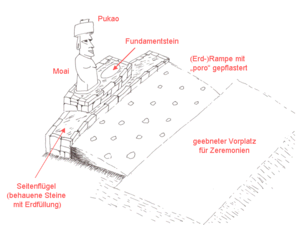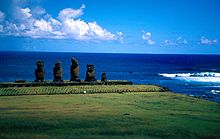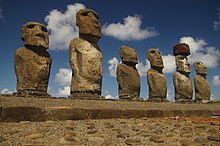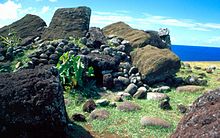Ahu (Easter Island)
An ahu is a ceremonial site on Easter Island that forms the structurally manifested, spiritual link between the world on this side and the other. The complex is endowed with high spiritual power ( mana ) and inviolability ( tapu ), but is also a symbol of political power. It usually consists of a stone platform with monumental stone statues ( moais ), to which a sloping ramp leads, and a leveled, rectangular area as a forecourt for ritual celebrations. So far, 255 Ahu are known on Easter Island in different states of preservation, 164 of them with one or more sculptures.
The term ahu is also known from the Marquesas , Tuamotu Archipelago and the Austral Islands . There, however, he only refers to the raised platform as the end of a rectangular ceremonial square ( marae ), whereas on Easter Island the entire ceremonial complex is meant.
Building description
James Cook provided a first, albeit very imprecise, description of the building at the end of the 18th century:
“Some of these brick platforms are 30 or 40 feet long, 12 or 16 feet wide, and 3-12 feet high. It depends on the ground in this regard, for they are usually on the edge of a seaward facing bench so that the front appears 10-12 or more feet high and another not over 3 or 4 feet high. They are built, or rather covered, with hewn stone of considerable size and the execution is like the finest flat piece of stone work that we have in England. They didn't need any kind of cement and yet the joints are extremely tight, the stones are put together and set in a very artistic way. The side walls are not vertical, but inclined slightly inward, in the same way as the parapets are built in Europe, but all this care, work and skill has not been able to save this strange construction from the traces of all-consuming time. The statues, or at least many of them, are erected on these platforms. As far as we could judge, they end at about half their length in a kind of stump in the ground on which they stand. "
It was not until the 20th century that scientists tried to examine the construction method more closely. Katherine Routledge , who visited Easter Island at the time of the First World War , divides the ceremonial platforms into four types of construction according to the type of construction and the extent of the equipment (the order is in principle still valid today, but later researchers sometimes make further subdivisions) :
- Rectangular Ahu (rectangular ahu) - rectangular, simply built, low stone platforms without statues, possibly the original form on Easter Island.
- Ahu with colossal statues (image ahu) - the most common and largest design
- Half-pyramidal ahu (semi-pyramidal ahu) - structures made of unworked stones, of which around 50 are found on Easter Island. They have the shape of a very low, elongated, three-sided pyramid. The largest specimens are around 45 m long and a little over 3 m high, with one or more burial chambers. In some cases, fragments of abandoned statues are incorporated into the construction.
- Ahu Poe Poe - with a pointed oval floor plan in the shape of a canoe, the bow and stern of which are slightly raised. One or two stone-clad grave chambers are incorporated along the longitudinal axis. The design comes in 7 patterns, none of which have any statues. A well-preserved specimen west of Anakena is around 20 m long and 4 m high.
It is controversial whether this classification of the structures shows a chronological sequence of their construction. Routledge regards the simply built, rectangular ahu without statues as the oldest and the Ahu Poe Poe as the youngest form (possibly built after European influence). According to more recent findings, the two last-named types are mainly ossuaries in terms of their intended use and come from the late phase of Easter Island culture.

|
By far the most common and most scientifically researched form is the ahu with statues (image ahu). It consists of a stones deluded , elevated platform that is filled inside with dirt and debris. On some platforms, e.g. B. at the Ahu Tahira in Vinapu, the shell masonry is made of large, artistically processed and carefully fitted blocks ( megalithic wall ), with simpler structures only stones in their natural state were used. It is noticeable that the rear wall facing the lake is often more carefully laid out than the rest of the masonry. The stones are set without mortar, mortar was unknown on Easter Island. Heavy, oval stone slabs are set into the top of the platform, which serve as the foundations for the huge stone statues. The moai, which can weigh up to 40 tonnes and are only wedged with small stones at the base, rise from this with their backs to the sea.
The platforms on which the figures stand are often extended on the sides by slightly lower, stone-made side wings. Their function is unknown, they probably only served representative purposes to make the building appear more powerful. Some systems thus achieve a total length of up to 145 meters.
A ramp made of earth, often paved, leads to the platform over its entire length. In some complexes, poro (rolling pebbles) protrude from the paving, probably only as a decorative element.
In front of the ramp is a leveled, sometimes fortified, rectangular forecourt that served ritual purposes. The ceremonial square is usually demarcated from the surrounding area with marker stones. The regular religious ceremonies took place here.
“As I found out, they completely relied on their idols, which were erected in great numbers on the beach. They fell down in front of it and worshiped her. These idols were all carved out of stone, in the shape of a human, with long ears. The head was adorned with a crown. The whole thing was done artfully, which we were very surprised about. Around these idols were placed white stones twenty to thirty paces wide. "
During archaeological excavations, walled pits were discovered on the rear wall of some platforms, which served as crematoria .
“At the rear of the platform, lowered a few steps to a slightly sloping terrace, which ends in a low wall, rises a square wall that protrudes a little above ground level, as if it were connected to the platform. Human remains fill the inner chamber and bones are scattered between the loose stones of the platform and their foothills. "
Whether these cremation sites are a later addition or were already included in the construction of the Ahu is controversial.
The size and proportions of the Ahu and the number of statues are not subject to any recognizable regularities. There are both large ahu over 100 meters in length and stone statues up to ten meters high, as well as platforms with only a single, small figure. Most platforms only support one or two statues; those with more figures are rare. The largest plant is the Ahu Tongariki with a length of 145 meters and 15 moai. It can be assumed that at the head of the tribal society standing clans of Easter Island made their power visible through the size of the platform, the number of statues and the care of execution.
Most of the Ahu are on the north coast of Easter Island, but the largest and best-equipped facilities are mainly found in the south.
With a few exceptions, the ceremonial platforms of Easter Island are located on the coast, for the most part within a range of 500 meters from the tide line. In the classical period they were always associated with a settlement. There was a clear ranking at the distance between the residential buildings and the ceremonial complex, which reflected the strictly hierarchical society of Polynesia. Closest to the ahu were the paenga houses - particularly elaborately built houses reminiscent of upturned boats - of the chiefs and priests with a paved forecourt and earth ovens ( umu ) as well as the associated stone chicken houses ( hare moa ), followed by the particularly fertile ones Stone walls protected and mulched fields (similar to the Zocos in Lanzarote ). Only behind it, further to the interior of the island, were the more simply built houses of the ordinary tribal members in the middle of the remaining cultivated areas. This arrangement shows that the ahu served not only religious, but also power-political and representative purposes.
Purpose and ceremonies
The ahu - at least this is the case for the platforms with sculptures - is to be seen as a ceremonial site that primarily served to worship ancestors and where initiation rites for chiefs ( ariki ) and other high-ranking people took place. Other rites may have been linked to fertility and agriculture cults.
Today there is no doubt that the Ahu were also associated with a cult of the dead. Archaeological excavations have shown that there are recessed chambers with remains of bones in the platforms. In the classic times of Easter Island culture, the deceased was wrapped in tapa or totora reed mats and left to decay. As a rule, this happened on the leveled area in front of the ahu of the clan. When only the skeleton was left, the bones were placed in the ceremonial platform. Such a second burial is also common on other islands in the South Pacific and in parts of the Indo-Pacific region . This type of burial was probably only given to chiefs, priests and other high-ranking members of the tribes. The crematoria that were found at some of the facilities also show the connection to a cult of the dead. It is conceivable that the less high-ranking deceased were cremated here.
The Ahu did not lose their function as a burial place even after their destruction. Late burials were found in the caves created by the overturned statues at Ahu Vinapu and some other complexes.
Age
Archaeological research has shown that the ceremonial platforms have been extended, expanded or rebuilt over generations, often reusing older material. This makes dating individual systems extremely difficult.
Radiocarbon dates indicate the earliest erection period to be between 1000 and 1100 AD. Earlier dates are also available, but they cannot be unequivocally linked to the buildings. According to the archaeological studies, the main focus of construction activity was in the 14th and 15th centuries. Probably no new facilities were built after 1650 AD.
Current condition
Sometime between the discovery of Easter Island by the Dutchman Jakob Roggeveen in 1722 and the visit of James Cook in 1774, the systematic destruction of the Ahu by the islanders themselves began. In the middle of the 19th century there were no more undamaged ceremonial platforms on Easter Island. Despite intensive research, the causes are still controversial today. The reasons given include the following:
- Civil war and internal conflicts
- Cultural decline due to the influence of the Europeans
- ecological destruction followed by famine
- Assumption of power by a warrior caste
- Change to another religion, the Vogelmannkult
- Earthquakes and tsunamis .
The majority of the ceremonial complexes on Easter Island are still "in situ", ie with platforms that have been more or less destroyed and overturned moai. Some ahu have been rebuilt using modern technology since the 1950s. Particularly worth seeing on the south coast is the Ahu Tongariki, reconstructed in the 1960s with fifteen upright moai of impressive size, the largest ceremonial complex in the Pacific . The well-preserved Ahu Vinapu with its carefully fitted stones is a particularly beautiful example of the architecture of the classical period of Easter Island culture.
Parallels
The Polynesian origin of Easter Island culture suggests parallels on other islands in the Pacific. The erection of monumental stone statues is - besides Easter Island - known from the Marquesas , Pitcairn , Raivavae , Hawaii and Tahiti . Ceremonial platforms without statues ( marae ) occur on almost all Polynesian and some Melanesian islands. They usually consist of a cleared and leveled area with a stone, terraced raised, sometimes stepped platform and have an obvious resemblance to the rectangular Ahu without statues of Easter Island, possibly the oldest design.
Web links
Individual evidence
- ↑ a b Helene Martinsson-Wallin: Ahu - The ceremonial stone structures of Easter Island. Societas Archaeologica, Uppsala 1994
- ^ A b Patrick Carlton McCoy: Easter Island Settlement Patterns in the Late Prehistoric and Protohistoric Periods. ( Dissertation ), Bulletin of Easter Island Committee - International Fund for Monuments, No. 5, 1976
- ↑ James Cook: A Voyage towards the south Pole, and round the world. Performed in His Majesty's Ships the Resolution ans Adventure, in the year 1772, 1773, 1774 and 1775. Written by James Cook, Commander of the Resolution , London 1777
- ^ Katherine Routledge: The Mystery of Easter Island. Cosmo Classics, New York 2005, ISBN 1-59605-588-X (reprint)
- ^ A b Sebastian Englert : Island at the center of the world - New light on Easter Island. Charles Scribner's Sons, New York 1970
- ↑ John Flenley & Paul Bahn: The Enigmas of Easter Iceland. Oxford University Press 2002, ISBN 0-19-280340-9




